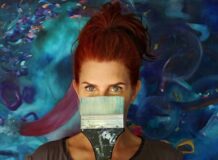Praxis International Artis pleased to present Timetraces, the solo exhibition by Esteban Pastorino (b. 1972, Buenos Aires). A reception to celebrate the opening will be held at 541 West 25th Street, on Thursday May 16th, 2013, from 6-8 pm.
Esteban Pastorino’s visual paradoxes are the result of his fascination for building artefacts which are capable of producing an illusion in the senses of viewers. To some extent, he develops a ritual of magic echoes which relate him to the passionate pioneers of photography in the 20th century, particularly to those who focused on the genesis of devices with the capacity to freeze motion, to extend the visual field or to simulate tridimensionality. Arthur Batut and Eadweard Muybridge belong to that group. In 1890, Batut developed a device which was capable of taking aerial photos from a kite, broadening – due to apparatus’ versatility, the possible uses of zenithal visions which had already been obtained for the first time, from an aerostatic balloon, by Nadar in 1858. Muybridge became famous for his panoramas and chronophotos, whichfragmented and froze motion of people and animals. His research work to simulate image animation led him to the invention of the zoopraxiscope, considered by many as the precursor to the movie projector. The 19th century and early 20th century were rich in experiments of this kind and they used to be greatly acclaimed at universal exhibitions, where audiences were captivated by these inventions of disquieting names: zoetropes, phenakistiscopes, kinoras, kinetoscopes, folioscopes, dioramas or cameras and stereoscopes. In some cases, the abovementioned devices had scientific applications, in others, they were merely aimed at amusement given that they were merely points of view or perceptions of reality which were not accessible to the human eye.
Pastorino’s photos display the coexistence of technique, the conjuring-up of childhood, the doubt regarding the veracity of the original subject and a call to reflection on the scenery that surrounds us. Ultimately, they stand as a proposal to distort the representation based on cameras and lenses which provide a high level of hyperrealism and manage to achieve a high level of fiction. Every attempt to encompass and unveil what the human eye cannot see, drives us further away from reality. Thus, the stereoscopic techniques turn landscapes into unreal sceneries in which the first aspect that becomes visible is theirtheatricality. From this viewpoint, Pastorino’s work is in line with the perception of reality as an imitation upheld by postmodernism, maintains the allure of images and allows us to go a step beyond mere technical spectacularity, setting us into that territory of artifice, dreams and visions cherished by the Baroque. It even gives a twist to the famous statement by the American photographer Gary Winogrand, which has become a motto for many artists: “I photograph to see what the world looks like in photographs”. Pastorino seems to follow Oscar Wilde’s words, “The true mystery of the world is the visible, not the invisible”, down to the smallest detail. A suitable point of view or the right equipment will suffice to represent it as something alien to our inertial perception of things.
Yet, after having outlined the philosophical, social and cultural implications of Esteban Pastorino’s photos, I still believe their most enticing aspect lies in that they are an invitation to play. He, himself, seems to wish to underplay his role as a visual creator when he explains his working methodology. Given that many of his photos have been shot with a camera attached to a kite, the shutter must be activated without the photographer’s awareness of what the camera is seeing and, therefore, also unaware of the frame and contents—the paradigms of authorship for many photographers — which depend to a large extent on chance. It is said that the software used for further manipulation of digital photos works as a second shutter which is co- responsible for the final construction of the image. In this case, this second shutteris activated randomly thus becoming the co-author of the photos. A blatant provocation for an era in which most artists devote significant efforts and sophisticated strategies to access that intentionally elitist place held by contemporary art in our society.
Esteban Pastorino Díaz was born in Buenos Aires, Argentina in 1972. In 1993 he graduated with a Mechanical Technician degree, and after three years of studying mechanical engineering, Pastorino transitioned his long-time passion for photography into a full-time career. He studied photography at the Academy Fotodesign (Buenos Aires). He was later selected as artist-in-residence for the Photography Center of Skopelos (Greece), the Rijksakademie Van Beeldende Kunsten (The Netherlands), Casa de Velázquez (Spain) and Fiskars Artist Residency (Finland). Over the course of his career he has received numerous distinctions, including the Leonardo Award for Photography (National Museum of Fine Arts, Argentina), Abraham Haber Award for Photographer of the Year (Argentina Association of Art Critics) and Konex Foundation Prize. His work has been exhibited internationally and included in the collection of important museums as Museum of Fine Arts, Houston; Museum of Fine Arts, Boston; Art Institute of Chicago; Santa Barbara Museum of Art; El Museo del Barrio; Princeton Art Museum; Museum of Latin American Art, Buenos Aires; Museum of Contemporary Art, Buenos Aires; Kiyosato Museum of Photographic Arts, Japan among others. In 2006 his work was included in the book Vitamin PH: New Perspectives in Photography (Phaidon Press) as one of the emerging artists.
20 May 2013
